Birding in Bhutan, Land of the Thunder Dragon
Birding in Bhutan, Land of the Thunder Dragon
Wildlife Trip Report Feb 25th – March 7th 2019 by Richard Baines
Yorkshire Coast Nature, Red Panda Travel and Bhutan Birding team up on a journey through Bhutan exploring one of the most magical countries in the world, where gross national happiness is the key to government targets. This is an exert from my day to day journal. Click Here to download the full report with many more photos.
Day One Birding in Bhutan (YCN/Red Panda tour)
There is no easy way to get to Bhutan, but by the end of day one in this unique country we knew the long journey was worth it. We flew emirates via Dubai to Kathmandu. A short stopover in Kathmandu on the way and on our return is not only a necessity it provides a wonderful opportunity to see experience this fabulous city.
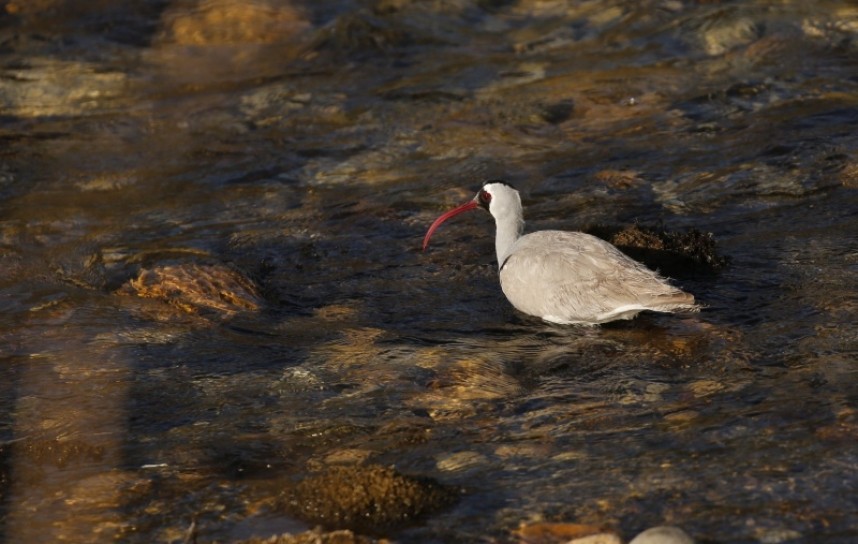
Ibisbill © Richard Baines
We landed in Paro at around lunch time after a short flight from Kathmandu. An incredible journey along the edge of the Himalayas. “make sure you sit on the left on your arrival and the right on your return” was our advice. We managed the right-hand side of the plane when we left Paro. Approximately half way through the flight we heard what must be one of the most iconic pilots’ announcements in the world; “If you look across to your right, we are now flying past Everest!” Not just Everest a fantastic view of the whole range, the top of the world.
After we land, we are quickly on our way to Thimpu and our hotel. We were keen to stretch our legs and binoculars! Luckily the road runs alongside Raid?k River where it didn’t take long to find our first Ibisbill, almost the first bird of the trip! Alongside the Ibisbill were Plumbeous Water Redstart, White-capped Water Redstart, Green Sandpiper, Common Sandpiper and in the trees above the river several Oriental Turtle Dove.
Day Two Birding in Bhutan (YCN/Red Panda tour)
Rising early, we drove up to Dochula Pass for breakfast at a traditional restaurant in a stunning location at 3150m. Cold weather overnight had left a white sheet of crisp snow and ice draped across the trees and rocks. This was our first taste of the huge landscapes and massive forests of Bhutan, we were all blown away by the magnificent views.
A short drive below the pass are the Botanical Gardens a great place to start forest birding in Bhutan. These botanical gardens are unusual, no formal flower beds or glasshouses just the natural beauty of the forest with gentle access along quiet paths and small wetlands.
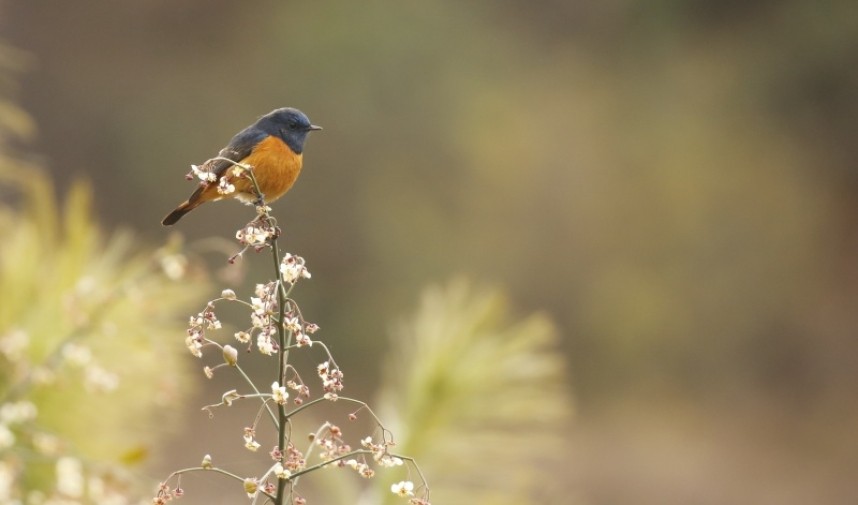
Blue-fronted Redstart © Richard Baines
By the entrance gate a male Blue-fronted Redstart greeted us and became our first of many brightly coloured birds on the trip. Nearby three Red-headed Bullfinch gave great views. As we entered a Kalij Pheasant ran into the undergrowth and Rufous Sibias fed on nectar from newly emerging Rhododendron trees. Along the forest path we discovered a flock of Chestnut-crowned Laughingthrushes moving noisily through the undergrowth alongside Streak-breasted Scimitar Babblers. Further along the path a small group of Brown Parrotbill, and Rufous-vented Yuhinas moved through the trees and scrub. White-browed Bush Robin, Green-tailed Sunbird and Fire-tailed Sunbirds.
Driving further down into the valley we stopped at a site for Yellow-rumped Honeyguide. These unique birds feed on the wax from bee hives and nest close to the bees. We had great views of several birds on a cliff side and by the side of a small stream, joining the Honeyguides on the cliff was our first of many Wallcreepers on the trip. On the side of the road and very unconcerned by our presence were two Slaty-backed Forktail. In the forest nearby were Grey-chinned Minivets Whiskered Yuhina and White-tailed Nuthatch.
We dropped down from the jungle hillsides eventually reaching the Punakha Valley. Stopping for landscape photos at the confluence of the Phochu Mochu, we noticed a family of six Common Otters playing by the side of the river with two Ruddy Shelduck stood watching the party nearby, this was a good phone-scoping opportunity made all the more impressive as the Otters were playing not far from the towering Palace of Great Bliss, winter residence of Bhutan’s chief Abbot. Above the Palace or Dzong, two Pallas’s Fish Eagle soared over the nearby forest adding their power and grace to the fantastic scene below.
Day Three Birding in Bhutan (YCN/Red Panda tour)
Our hotel was located in a fantastic location high above the Punakha Valley where we could see the river and Dzong below. Whilst carrying our bags to the car a male Hodgson’s Redstart hopped around our feet and a Grey-backed Shrike soaked up the early morning sun perched nearby.
Our destination today was the Phobjekha valley, the famous place where most of the worlds Black-necked Cranes spend the winter. Our route took us through many forests from Brown Oak and Rhododendron to Cheer Pine and evergreen broadleaf moist jungle. Or first stop was at three close and mature Silk Cotton Trees in full flower. These impressively red flowers stand out like beacons in the green jungle. The nectar is irresistible to many forest birds. As soon as we got out of our car a Lesser Yellownape caught our eye at the top of the first tree. We then spent over an hour watching and photographing many species in the Cotton Trees including Orange-fronted Leafbird, Great Barbets, Blue-throated Barbets and Golden-throated Barbets, Rufous Sibia and Black Bulbuls.
Day Four Birding in Bhutan (YCN/Red Panda tour)
A bedroom window overlooking the wide grasslands of the Phobjekha valley, flanked on all sides by forests and mountains is a fantastic sight, add an inch of snow and it gets even better! Just after dawn we could hear the first Black-necked Cranes, a magnificent sound echoing around the valley, no wind, just crisp silence, broken only by the sound of wild cranes.
Behind our hotel the forest and scrub harboured a flock of 50 or so thrushes, the majority were Red-throated Thrush, a smaller number of White-collared Blackbirds and one Black-throated Thrush. On the edge of the forest were Russet Sparrows, Beautiful Rosefinches, Rufous-breasted Accentors and several Rufous-vented Bush Tits. A short walk into the grasslands and we were surrounded by a flock of 2-300 Oriental Skylark and on the road side in the village an impressive flock of up to 1,000 Plain Mountain Finches.
After a drive up the narrow road to the top of the pass at 3,300m we entered open pine forest. A small group of White-throated Redstarts moved across the road, we managed good views of what must be one of the most beautiful Redstarts in Himalaya. This was the first of six Redstart species in one day, a very special occasion. The common Blue-fronted Redstarts and Hodgson’s Redstarts kept us company almost everywhere we stopped, in the rivers were Plumbeous Redstarts and White-capped Water Redstarts then out of the mist the most unexpected of them all… Whilst we were stood overlooking the Trongsa Valley on the balcony of a local café, I noticed up an unusual bird at point blank range flying in a similar way to a woodpecker or finch. Red belly and tail, big white wing flashes on a black mantle and head…Guldenstat’s Redstart! It flew right past us looking awesome in its flight action and colour. A very lucky sighting as they are a rare bird in this part of Bhutan. It was likely the snow and bad weather at higher altitudes had pushed it lower into the valleys. Below us Chestnut-crowned Laughingthrushes moved through the edge of the jungle.
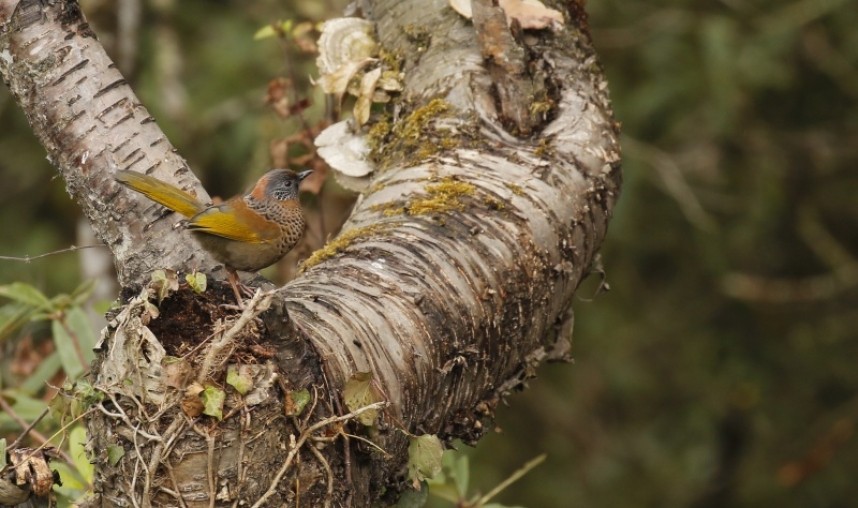
Chestnut-crowned Laughingthrush © Richard Baines
Day Five Birding in Bhutan (YCN/Red Panda tour)
One of the great things about staying in the thick of things i.e. hotels in birding habitat, are the high chance of finding good birds right outside your room. Within seconds of opening my room door six Bar-throated Siva flew into a tree only a few meters away. We left our hotel at 0700 to get onto the road and into the forest just after dawn. It paid off straight away with fabulous views of several Rufous-breasted Bush Robins and Himalayan Bluetails. The forest was predominantly evergreen broadleaf and the bird assemblage was typical of an altitude of around 1,500-2,000m. Rain overnight and the cool breeze from the mountains gave the forest a real Himalayan foothills region feel. A big foraging flock graced our group. We had great views of many species including Rufous-gorgeted Flycatcher, Scarlet-breasted Flowerpecker, White-browed Shrike Babbler, Striated Laughingthrush and Rufous-vented Yuhina.
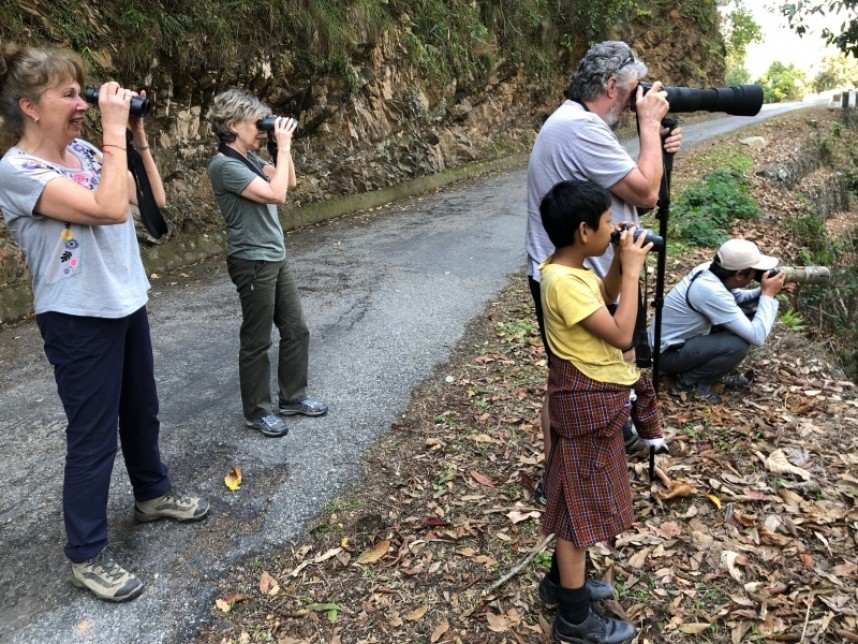
Jungle birding with our YCN & Red Panda team© Richard Baines
Shortly before we arrived at our overnight stay in Tingtibi we stopped by the river to look for White-bellied Heron, no sign but the birdlife and temperature had changed to a more tropical feel in lowland humid, evergreen broadleaf forest. A colourful Silver-eared Mesia dropped in by the side of us and nearby an Asian Barred Owlet sat peering at the forest floor. At the T-Wang Hotel I was given room 108, a very auspicious number in Buddhism, the events of the following day made me believe it…
Day Six Birding in Bhutan (YCN/Red Panda tour)
We awoke early morning with the sound of Rufous-necked Laughing-thrushes and Rusty-cheeked Scimitar Babblers squabbling in the shrubs below our window. After breakfast a short drive into the forest was followed by a very memorable birding walk. The low cloud shrouded the forest in mist creating a magical atmosphere, the stillness of the forest broken only by beautiful bird sounds. Three Emerald Doves by the side of the road, a Yellow-vented Warbler feeding in bamboo, a male Rufous-breasted Niltava a pair of Small Niltava gave us great hope for the day. As the sun broke through the clouds, we started to pick up new species. An unfamiliar bird call led Norbu and I to a tree where we stood in intense concentration looking for what was making the sound. Steve arrived and said “have you seen that Hornbill sat right in front of you?” We had missed what was right in front of our faces; a male Rufous-naped Hornbill!
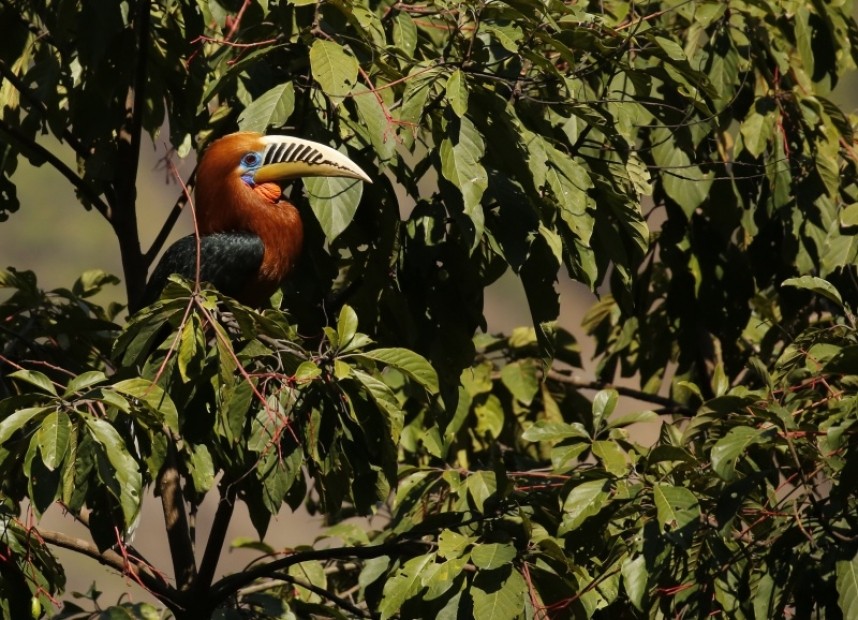
Rufous-necked Hornbill © Richard Baines
For the following two hours we enjoyed fantastic views of both Rufous-naped Hornbill and Great Hornbill. The best place in Bhutan for close views of Hornbills certainly produced the goods today. Nearby a feeding flock gave us great views of our first Sultan Tits. A flock of Nepal House Martins fed above the forest as a Giant Squirrel climbed a tree full of Golden Langur monkeys.
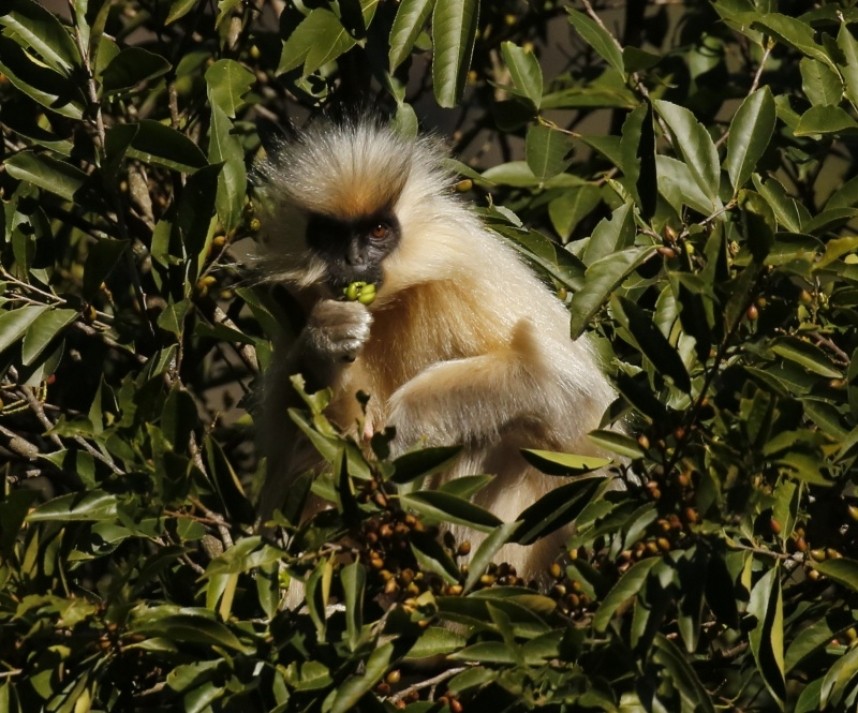
Golden Langur © Richard Baines
Day Seven Birding in Bhutan (YCN/Red Panda tour)
I was outside the hotel at dawn again to be immediately greeted by two Chestnut-tailed Starling and several Streaked Spiderhunter joined the local birds feeding in the village. We left Tingtibi at 0700 heading for the town of Gelphu close to the Indian border. We climbed to approximately 2,040m and spent some time birding the Tamala pass. One of many great things about Bhutan are the quiet roads. Driving at a very slow pace we stopped several times for birding as we climbed higher and higher into the dense jungle. A small farm house and garden produced a fantastic rush of birds. Feeding on the ground in a stock paddock were a flock of Olive-backed Pipits, a Rufous-breasted Accentor and a Little Bunting. On the fence posts surrounding the paddock a Grey-backed Shrike kept a beady eye on proceedings. In the jungle a Sikkim Treecreeper crept silently up a huge tree. Close by a Common Green Magpie fed on insects amongst the epiphytes. Higher in the canopy we noticed a flock of Scarlet Finches, hard to miss with their scarlet red plumage and ivory white bills.
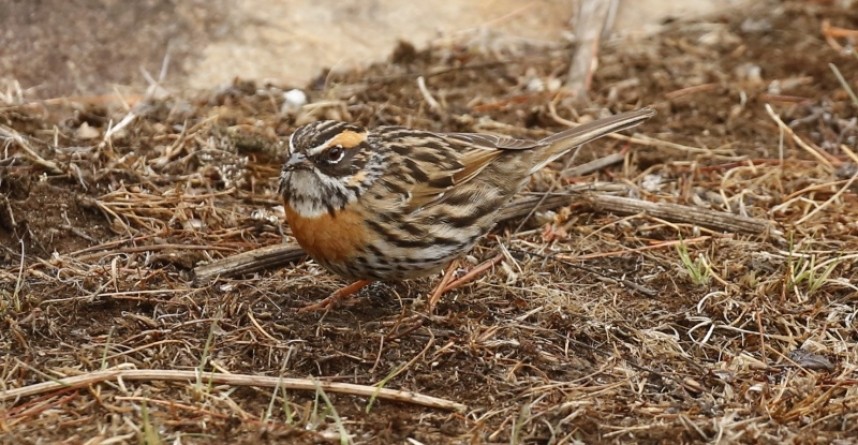
Rufous-breasted Accentor © Richard Baines
Moving further south we dropped in altitude to around 1,000m. This mid-altitude forest tends to attract a different suite of birds in the warmer climate. Another feeding flock and another big bird rush! New birds in this area included White-bellied Erpornis, White-browed Piculet, Speckled Piculet, Mountain Tailorbird and Grey-cheeked Warbler. Sitting nearby in a forest clearing were several Bronze Drongo and a very handsome Lesser Racket-tailed Drongo. Great views of three Grey-capped Pygmy Woodpecker included a red-headed male of the eastern subspecies. Our final jungle bird of the day before we arrived into the lowlands was a new raptor for the trip a juvenile Rufous-bellied Eagle.
We arrived in Gelphu at around 4pm giving us time to check into our hotel and then catch the last couple of hours birding on the edge of the town at the sewage ponds. This does not sound very appealing but as many birders will know where there’s muck there’s birds! This area proved to be one of the cleanest and impressive habitats close to sewage ponds I had ever visited and even better there were loads of great birds; Hill Myna, Little Egrets, Cattle Egrets, Indian Pond Herons, Indian Roller, Himalayan Flameback, Chestnut-headed Bee-eater, Green Bee-eater, White-throated kingfisher, Common Sandpiper, Green Sandpiper, Red-wattled Lapwing, Yellow-wattled Lapwing, White-breasted Waterhen, Common Snipe, Citrine Wagtail, Water Pipit and great views of a single Pintail Snipe. Potentially even better was a probable Paddyfield Warbler feeding low down in tall ruderal vegetation near the entrance gate and on a bush above the warbler we found a female Brown Shrike.
Day Eight Birding in Bhutan (YCN/Red Panda tour)
After the previous day’s sighting of Paddyfield Warbler we decided an early morning return to the sewage ponds would be good to see if we could get any photos of this very rare bird in Bhutan. There was no sign of the Paddyfield but we found a male Siberian Rubythroat and a Dusky Warbler. On the two visits we found four iconic Siberian songbirds. In an area less than 100m². Even more evidence that this little corner of Bhutan can turn up some great birds.
After lunch we headed further west towards Thimpu, on the way calling in at a site for White-bellied Heron. The Royal Society for the Protection of Nature (RSPN) in Bhutan guard every nest and this one already contained four eggs, an early nesting start compared to previous years. Nearby, a flock of Olive-backed Pipits fed on rice fields and a Common Green Magpie sat shrike like on a fence post. RSPN manage the White-bellied Heron and Black-necked Crane projects in Bhutan. We will be continuing to liaise with RSPN so we can follow the fortunes of these beautiful birds and each of our future group trips will include a donation to RSPN.
Day Nine Birding in Bhutan (YCN/Red Panda tour)
Day nine in Thimpu was planned as a cultural day which included a visit to the Bhutanese government tourism department. The government requested a meeting with us to plan future trip liaison, provide us with resources and receive feedback from our tour. Our idea of close liaison with RSPN were well received, so we make sure our group trips create a positive conservation legacy helping both wildlife and tourism.
After our meeting and shopping in the local market for presents and crafts, we spent a very productive few hours birding along the river between Thimpu and Paro. Little Buntings, Olive-backed Pipits, Grey-backed Shrike, Brown Dipper and around 100 Red-billed Choughs were seen by our group. Bhutan is the best country in the world to see Ibisbill and this was confirmed again with two by the roadside on the gravel beds in the river, fantastic views of this unique bird. We visited a small wetland site in search of Black-tailed Crake and right on cue two birds fed on the edge of the mud beneath us. Our day was completed at Hotel Olathang. This grand building in a peaceful forest setting was built in 1974 to house international guests attending the king’s coronation. My mind was immediately drawn to the potential for good birding before breakfast the following morning...
Day Ten Birding in Bhutan (YCN/Red Panda tour)
Early morning outside Hotel Olathang White-collared Blackbirds singing, Yellow-breasted Greenfinches, Eurasian Jays and Yellow-billed Blue Magpies flying out of their roost into the Cyprus trees below us. After breakfast we headed for the most sacred temple in Bhutan, the world-famous Tigers Nest. Perched on a sheer cliff 3,000m above sea level and surrounded by Blue Pine, Brown Oak and Rhododendron forest Tigers Nest is not only a stunningly beautiful cultural site it’s also a pretty good birding experience.
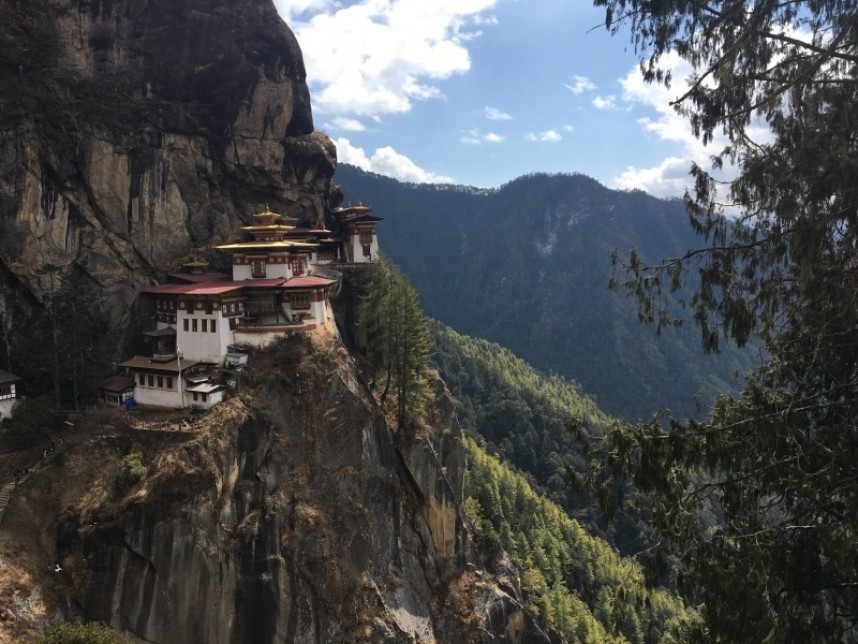
Tigers Nest © Richard Baines
The climb is a steady two hour walk, up a wide well-worn track with a small café approximately two thirds of the way up. We took at least twice that time with lots of birds around, beautiful forest and fantastic landscapes to savour. After a bit of searching we were rewarded with good views of both Rufous-bellied Woodpecker and Darjeeling Woodpecker. At the café a small outflow water pipe created a bathing pool which was a magnet for birds especially Yellow-billed Blue Magpies.
At around 3,000m near the temple of Tigers Nest we found six very confiding Alpine Accentors, very close by a mixed flock of over 20 Altai Accentors and Rufous-breasted Accentors. There can’t be many places in the world where you can see three species of Accentor so close together. In low Willow scrub below the temple a male Dark-breasted Rosefinch, Eurasian Wren and Black-faced Laughingthrushes and a flock of Snow Pigeon flew by.
This was our last day in Bhutan. We were left with unforgettable wildlife and cultural memories from wild mountains, sparkling rivers to forests and jungle as far as the eye can see. Everywhere we went the people were incredibly gentle and kind, Bhutan truly is a magnificent country.
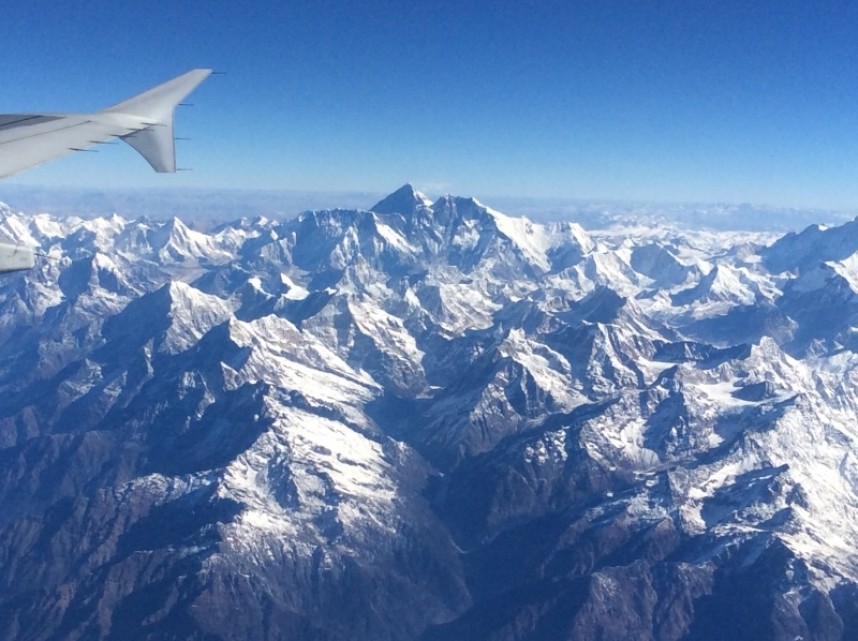
Everest from the Paro to Kathmandu flight © Richard Baines
Birding and Wildlife of Bhutan 23rd February – 6th March 2020
Yorkshire Coast Nature, Red Panda Travel and Bhutan Birding. A tour combining great birding and wildlife watching in search of speciality species in the jungles, mountains and valleys of Bhutan. Incredible scenery, optional cultural visits to sacred temples and a short stay in Kathmandu. Leaders Richard Baines and Norbu, Birding Bhutan. Numbers limited to 10.
For a full 2020 itinerary and costs please email richard.baines@yorkshirecoastnature.co.uk or call Richard on 07747753260.



 Back to Blog
Back to Blog
